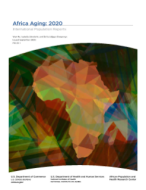For Immediate Release: Wednesday, September 02, 2020
Census Bureau Releases New Report on Aging in Africa
SEPT. 2, 2020 — A new report released today by the U.S. Census Bureau provides analysis of the demographic, economic, social and health characteristics of the older African population, with a focus on sub-Saharan Africa.
The report, “Africa Aging: 2020,” looks at the implications of population aging for Africa as a region, subregions and countries at present and in the future. It provides comprehensive and up-to-date statistics on current and projected future population aging trends and patterns in Africa and sub-Saharan Africa.
Highlights include:
- Between 2020 and 2050, the older African population is projected to triple from 74.4 million to 235.1 million. Its growth in the next three decades will outpace that of any other region of the world.
- A majority of African countries have less than 7% older population in 2020; by 2050 it is projected that just over one-fifth of countries in the region will still have the low proportion of older population.
- Nigeria has the 19th largest older population in the world in 2020, which is projected to rise to the eleventh largest in 2050.
- Africa has the highest total dependency ratio in the world, with children representing a much heavier societal support burden than older people.
- Whether in rural or urban areas, the large majority of older Africans have limited geographic mobility, having stayed in the same locality for 10 years or more.
- Seven in 10 adults ages 60 to 64 and almost half of those age 65 and older in sub-Saharan Africa remain in the labor force, a higher share than in all other world regions.
- Noncommunicable diseases dominate in older adults in Africa, as they do globally, but infectious diseases are still relevant as causes of mortality in this older population.
- Older African women have reported higher rates of disability or functional limitations compared to men. They are also more likely to report a greater severity of difficulties performing activities of daily living.
- Health systems for African older adults, rural residents in particular, suffer from understaffing of health workers, insufficient financial resources, inadequate legal health coverage, and high out-of-pocket payments.
This report follows the United Nations definitions of world regions and subregions. For more information go to Geographic Regions for Statistical Use. Demographic estimates and projections data come from the International Data Base, which is maintained and updated by the Census Bureau’s Population Division and current as of November 2019. All comparative statements in the text have undergone statistical testing, and comparisons are significant at the 90 percent confidence level, unless noted otherwise.
Research for, and production of, this report were supported by the Division of Behavioral and Social Research, National Institute on Aging.
No news release associated with this report. Tip Sheet only.
###




